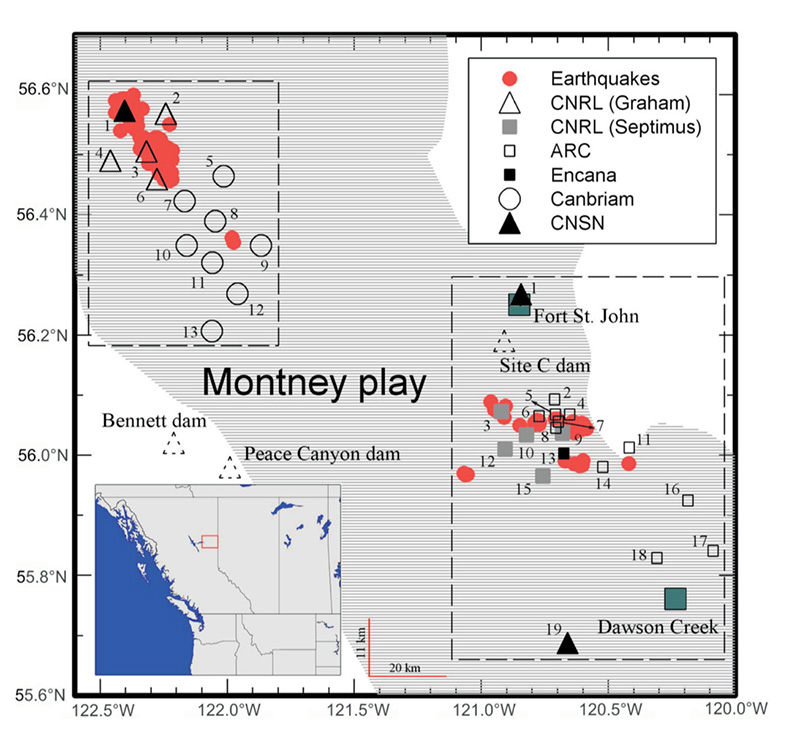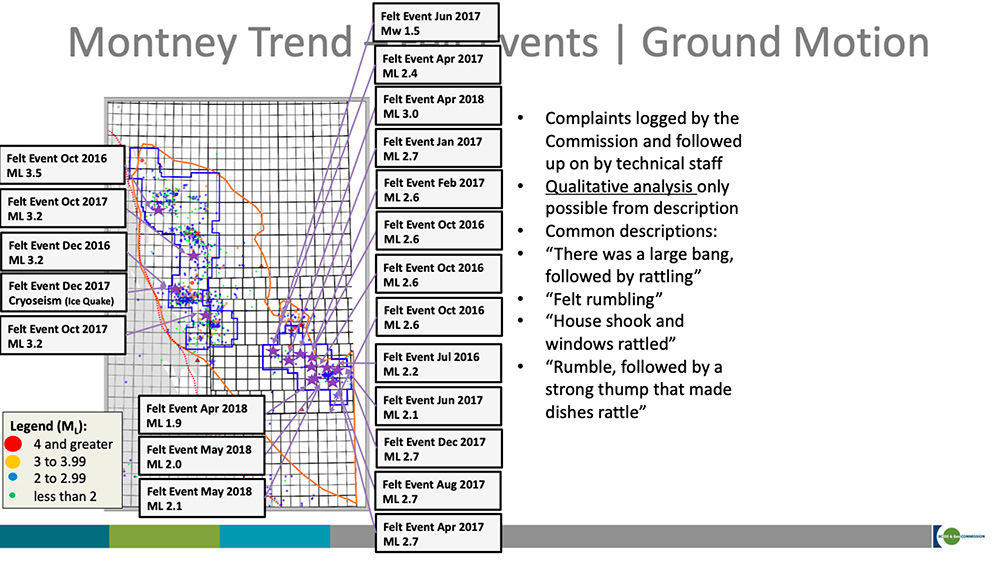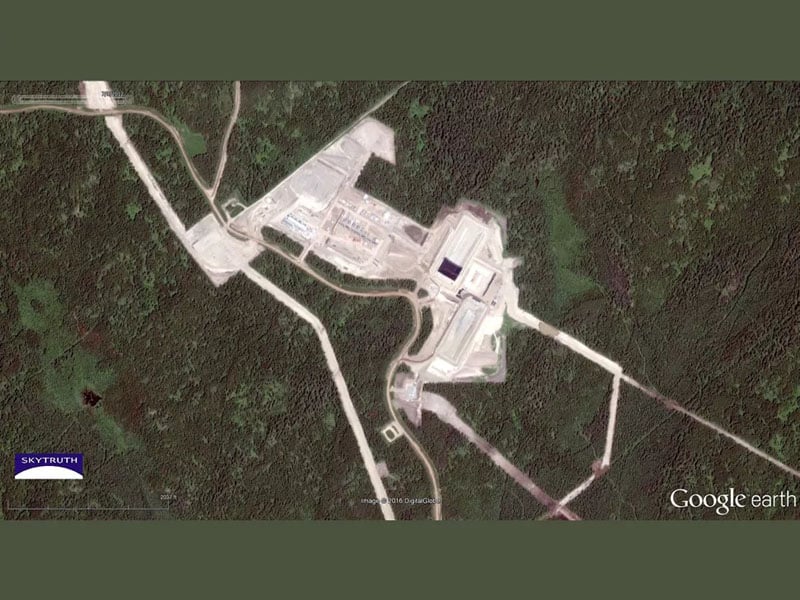Last month’s shutdown of some Canadian Natural Resources Ltd. operations after they likely triggered earthquakes was not the first time the corporation has been linked to tremors in northeastern B.C., The Tyee has learned.
The BC Oil and Gas Commission ordered the company to halt operations for 30 days last week after earthquakes rattled Fort St. John and the Site C dam project.
Six companies close to the investigation area have also suspended hydraulic fracking operations.
Just two years ago the commission ordered Canadian Natural Resources Ltd. (CNRL) to change its procedures and improve seismic monitoring at a salt water disposal and storage well (Septimus A7-5) south of Fort St. John after a swarm of tremors, including a widely felt 3.9 magnitude earthquake.
The industry’s wastewater disposal wells, along with fracking, can trigger earthquakes. Fracking — the underground injection of water, chemicals and sand under high pressure to shatter rock formations and allow oil and gas to flow — can release toxic salt water, which along with frack fluids is pumped underground in disposal sites. Almost 90 per cent of all gas in B.C. now comes from fracked wells.
In 2012, CNRL gained approval from the commission to use a former gas well as both a source of water for its fracking operations and a place to dispose of salt water and fluids from fracturing.
But in 2015, the injection of waste fluids at the site triggered a series of quakes.
CNRL’s own seismic monitoring system in the area recorded “81 events for the period between April 16 and Oct. 12, 2014,” according to a recent scientific paper on ground motion caused by industry made quakes.
The oil and gas commission immediately suspected CNRL’s injection well had caused the tremor.

“These events could likely be attributed to the operation of this specific well,” said the OGC in a letter to the company. The letter noted the injection well was located near a known geological fault.
The letter added the commission was “concerned that continued disposal at recent rates and pressure have a likelihood of triggering additional events with potential associated loss of wellbore integrity and fluid containment.”
A year later the OGC again raised similar concerns in a letter to CNRL, this time including operations at a second disposal well, Septimus B2, which had been approved in 2012.
Once again the commission warned CNRL that the “disposal operation of the subject wells has been coincident with a number of seismic events of varying magnitude and frequency.”
The quakes could affect the integrity of the well and cause leaks and the migration of waste water, the letter said.
CNRL had requested approval to increase injection pressures at the well that originally triggered the quakes.
But the oil and gas commission said the history of quakes raised fears that increasing the pressures could lead to “fluid migration out of the approved formations should pressure increase.” In other words, fluid from the injection well could escape into groundwater, other wells or come to the surface.
The company wanted to continue operating both wells until October 2018, but the OGC said no. It gave the company until April 2018 to shut them down.
In early 2018 CNRL drilled a new horizontal well to dispose of wastewater to replace the other two wells. In B.C. companies must drill their own wells and then prove to the OGC that there disposal wells won’t leak or cause earthquakes.
In approving that new wastewater injection well, the regulator noted that “in certain circumstances, disposal well operation may induce seismicity of values that require modification of operations to mitigate.”
It also reminded CNRL that “seismic events must be reported and disposal operations suspended” when a well triggers a magnitude 4.0 earthquake or ground motions felt by any individual within a three-kilometre radius of the well.
The regulator has now confirmed that CNRL’s initial troublesome well, Septimus A7-5, is part of the investigation into the recent quakes that rattled and unnerved homeowners in the region.
The commission ordered CNRL to stop all hydraulic fracturing operations just eight kilometres from the Site C dam after a 4.5 quake and two other tremors rattled homes and residents in the region.
An additional magnitude 2.7 quake occurred in the same region after the cessation of injection activities on Dec. 7 about 25 km southeast of Fort St. John.
When contacted by The Tyee, CNRL refused to discuss the shutdown order or any seismic incidents caused by the company’s operations.
“Canadian Natural is working together with the BC Oil and Gas Commission to provide all available data and information for their assessment of the event. We have no other information to provide,” said Julie Woo, public affairs manager for the company in an email.
When asked, the OGC said it did not have any concerns about CNRL’s past role in triggering quakes.
“The Commission has put in place new regulations and requirements to deal with induced seismicity,” replied Lannea Parfitt, a communications manager with the OGC, in an email.
Since 2015, oil and gas operations that cause magnitude 4.0 quakes must report to the commission and shut down operations. In one region prone to tremors, south of Fort St. John (the Farmington area) the threshold is magnitude 3.0.
In densely populated England, operators must shut down after a magnitude 0.5 quake.

As the liquefied natural gas has intensified in northeastern B.C. over the last six years, the industry has triggered thousands of earthquakes with four different kinds of fluid injection technologies: hydraulic fracturing; wastewater injection; acid gas disposal and enhanced oil recovery.
Some parts of the basin, including the area under investigation, seem to be more earthquake prone than others, say researchers.
The industry-triggered earthquakes have alarmed many local residents, caught regulators off guard and resulted in increased seismic monitoring and ongoing research.
Like naturally occurring quakes, industry generated tremors can pose a hazard to public safety, dams and other infrastructure, wellbore integrity and groundwater.
Many residents around Fort St. John claim their house foundations have been cracked by industry quakes.
Researchers and the OGC say they are still trying to quantify the risk and figure out “site specific” solutions.
The quakes shed light on the complexity of extracting hydrocarbons from shale formations two to three kilometres underground in northeastern B.C.
The shale gas fracking industry generates large volumes of waste water — now the largest byproduct of oil and gas production in North America — about 125 million barrels a year from the Montney formation.
Fracking also generates its own contaminated waste water stream known as “frack fluid flowback.”
In B.C. the industry can legally dispose of wastewater deep underground into 12 different formations on the assumption — questioned by some researchers — that it won’t leak to surface or migrate to other geological formations.
There are more than 100 deep injection wells in northern B.C. The LNG industry could require the construction of hundreds more to support increased fracking.
In recent years the OGC has shut down three injection wells because of earthquake hazards and closed down another seven as their reservoir pressure reached its threshold.
In one case the OGC discovered that one wastewater injection operator was actually targeting a seismically active fault because it took more fluid. “And so we put an end to that,” revealed OGC petroleum geologist Stuart Venables during a 2016 presentation on industry triggered quakes.
Gail Atkinson, a leading Canadian seismic hazard expert, recommended in a 2017 paper that fracking be banned from a five-kilometre zone around dams. She also recommended a 10-kilometre exclusion zone for disposal wells due to their higher impact as well as real-time seismic monitoring within 25 kilometres of all critical facilities.
“An avoidance strategy is useful and appropriate for those few high-consequence facilities (such as major dams) where the target reliability level is very high and the failure consequences are unacceptable,” advised Atkinson.
But the oil and gas commission has taken a mixed position.
The OGC’s Parfitt says there “is a five-kilometre buffer zone around the proposed Site C dam, Bennett and Peace Canyon dams and there are also restrictions on the sale of oil and gas tenure within a certain distance.”
Yet the OGC re-approved, with conditions including seismic monitoring, a wastewater disposal well just 3.5 kilometres from the Peace Canyon dam earlier this year.
The commission has said it was “the first regulator in North America to draw the link between hydraulic fracturing and induced seismic events and takes a leadership role in the detection and mitigation of induced seismicity from unconventional oil and gas development.”
But the U.S. Geological Survey made that connection almost 20 years ago in a 1990 report for the U.S. Environmental Protection Agency titled “Earthquake Hazard Associated With Deep Well Injection.”
It documented the fascinating history of earthquakes caused by wastewater injection and cited two Oklahoma incidents where “a massive hydraulic fracturing program” set off swarms of earthquakes as early as 1978 and 1979.
The report concluded that “The occurrence of any earthquakes, even as small as magnitude 0, near the bottom of a well, should be viewed with concern.” ![]()
Read more: Energy, Environment

















Tyee Commenting Guidelines
Comments that violate guidelines risk being deleted, and violations may result in a temporary or permanent user ban. Maintain the spirit of good conversation to stay in the discussion.
*Please note The Tyee is not a forum for spreading misinformation about COVID-19, denying its existence or minimizing its risk to public health.
Do:
Do not: